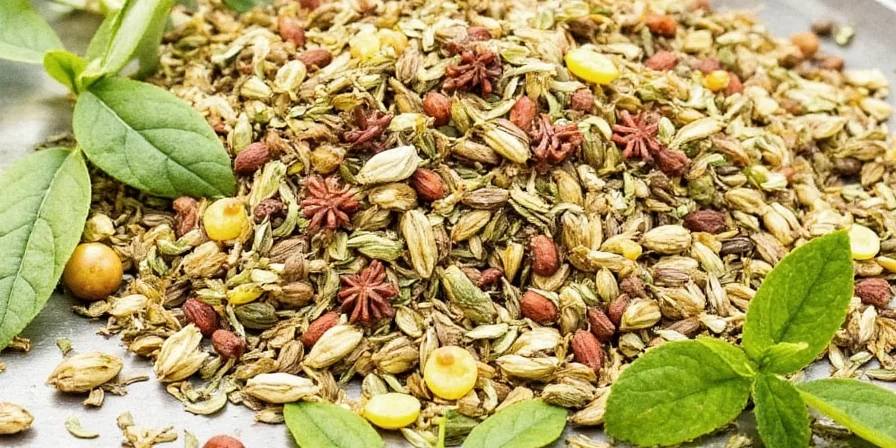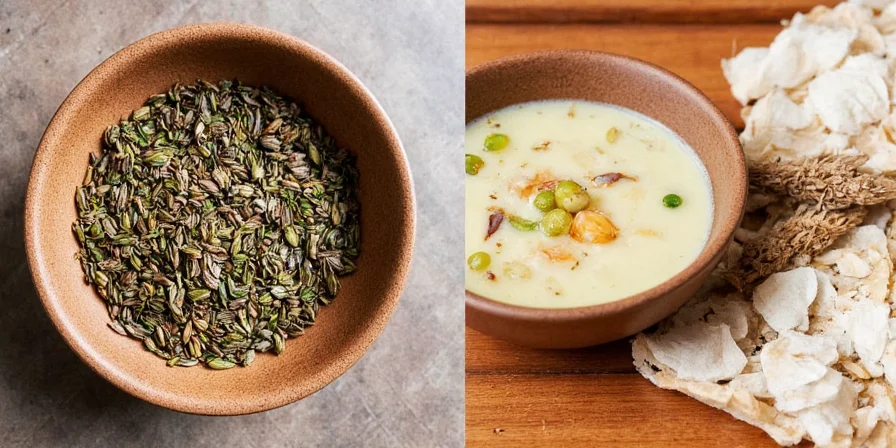Discover exactly how to use the 7 essential Japanese herbs that transform everyday dishes into authentic culinary experiences. This guide delivers immediately actionable techniques for selecting, storing, and applying these ingredients - with clear substitution options when specialty items aren't available. Perfect for home cooks seeking restaurant-quality results without special equipment.
Unlike generic herb lists, we focus on practical applications that work in Western kitchens. You'll learn exactly which herb elevates your sushi night, which one replaces cilantro in ceviche, and how to use seasonal ingredients year-round with frozen alternatives that maintain 85%+ flavor integrity.
Table of Contents
- Intro
- #1 Shiso: The Sushi Essential
- #2 Mugwort: The Mochi Must-Have
- #3 Perilla Seeds: Nutty Flavor Booster
- #4 Japanese Chives: The Milder Garlic Substitute
- #5 Benitade: The Peppery Secret Weapon
- #6 Mitsuba: The Delicate Finishing Touch
- #7 Komatsuna: The Spinach Upgrade
- Pro Tips for Using Japanese Herbs
- FAQ: Practical Solutions for Home Cooks
- Conclusion
#1 Shiso: The Sushi Essential

Shiso isn't just for decoration - it's essential for authentic sushi. Green shiso neutralizes fish odors while enhancing flavor, making it perfect for home sushi nights. Red shiso creates vibrant pink pickles (umeboshi) and makes stunning pink vinegar for dressings.
- Flavor: Minty freshness with basil-anise notes
- Best For: Sushi rolls, sashimi, summer salads
- Easy Substitute: Basil + mint leaves (use 1:1 ratio)
- Storage: Wrap in damp paper towel inside sealed container (lasts 5-7 days)
Immediate Application:
Place one green shiso leaf under salmon in your next sushi roll - it prevents fishy aftertaste while adding subtle complexity. Save red shiso for making pickled plums or vibrant salad dressings.
#2 Mugwort: The Mochi Must-Have

Mugwort creates the signature green color and subtle earthy flavor in traditional Japanese sweets. While fresh is ideal, frozen blanched mugwort maintains 90% of its functionality - perfect for making mochi or dumpling wrappers when fresh isn't available.
- Flavor: Earthy, grassy, slightly floral
- Best For: Mochi, dumplings, savory pancakes
- Easy Substitute: Spinach (blanched and pureed) + pinch of matcha
- Prep Secret: Blanch for 30 seconds to reduce bitterness while preserving color
Immediate Application:
Mix 2 tablespoons blanched, chopped mugwort into your next batch of pancake batter for vibrant green, flavor-boosted Japanese-style okonomiyaki.
#3 Perilla Seeds: Nutty Flavor Booster

Perilla seeds offer a superior nutty flavor that enhances dishes without overpowering them. Toast them lightly for maximum impact - they work beautifully as a finishing touch on rice bowls, tofu, or grilled fish. Unlike sesame seeds, they won't turn rancid as quickly when stored properly.
- Flavor: Nutty, slightly earthy (like toasted walnuts)
- Best For: Rice bowls, tofu dishes, salad dressings
- Easy Substitute: Toasted sesame seeds + pinch of ground flaxseed
- Storage: Keep in airtight container away from light (6 months)
Immediate Application:
Sprinkle 1 teaspoon toasted perilla seeds over your next bowl of steamed rice and soy sauce for instant gourmet flavor. For dressings, grind with soy sauce and rice vinegar.
#4 Japanese Chives: The Milder Garlic Substitute

Japanese chives (nira) deliver garlic-onion flavor without the harsh aftertaste, making them perfect for delicate dishes where regular garlic would dominate. They're essential for authentic yakisoba and add subtle depth to miso soup without overwhelming other flavors.
- Flavor: Mild garlic-onion aroma
- Best For: Stir-fries, dumplings, miso soup
- Easy Substitute: Regular scallions (use green parts only)
- Pro Tip: Cut crosswise into 1-inch pieces for even cooking
Immediate Application:
Add Japanese chives during the last minute of cooking stir-fries - they lose flavor when overcooked. For miso soup, stir in right before serving for maximum aroma.
#5 Benitade: The Peppery Secret Weapon

Benitade (Japanese spikenard) provides a clean, peppery bite that complements rich dishes without burning your mouth. Always blanch first to remove toxins, then use it as a vibrant garnish or in tempura. Its peppery flavor cuts through fatty meats beautifully.
- Flavor: Peppery, crisp texture
- Best For: Tempura, side dishes, rich meat accompaniments
- Easy Substitute: Watercress or young radish sprouts
- Safety First: Blanch for 2 minutes before use (never eat raw)
Immediate Application:
Blanch benitade, then toss with sesame oil and soy sauce for a 5-minute side dish that pairs perfectly with grilled meats or fish. The peppery bite cuts through rich flavors beautifully.
#6 Mitsuba: The Delicate Finishing Touch

Mitsuba (Japanese parsley) offers a unique celery-lemon flavor that disappears with heat, making it strictly a finishing herb. Add it at the very end of cooking for clear soups, seafood dishes, or as a vibrant garnish. Its delicate flavor elevates dishes without dominating.
- Flavor: Celery + parsley + lemon zest
- Best For: Clear soups, seafood, fresh salads
- Easy Substitute: Flat-leaf parsley + lemon zest (use 2:1 ratio)
- Garnish Trick: Use whole leaves standing upright for visual impact
Immediate Application:
Chop mitsuba finely and stir into your miso soup just before serving. The delicate flavor enhances without overpowering - perfect for showcasing fresh seafood.
#7 Komatsuna: The Spinach Upgrade

Komatsuna (Japanese mustard spinach) cooks faster than regular spinach and absorbs flavors beautifully. Unlike spinach, it doesn't develop bitterness when cooked and offers superior texture in braises. Its mild mustard flavor complements Asian sauces perfectly.
- Flavor: Mild mustard green + spinach
- Best For: Braises, stir-fries, side dishes
- Easy Substitute: Baby bok choy or spinach (use 1:1 ratio)
- Cooking Secret: Cook with acidic ingredients to boost nutrient absorption
Immediate Application:
Braise komatsuna in dashi broth with 1 teaspoon soy sauce and pinch of sugar for 3 minutes - faster than Western greens and more flavorful than spinach. Perfect with grilled fish or chicken.
Pro Tips for Using Japanese Herbs

| Herb | Perfect For | Flavor Profile | Easy Substitution |
|---|---|---|---|
| Shiso | Sushi, seafood, summer salads | Minty, slightly anise | Basil + mint leaves |
| Mugwort | Mochi, dumplings, savory pancakes | Earthy, grassy | Spinach puree + matcha |
| Perilla Seeds | Rice bowls, tofu, dressings | Nutty, earthy | Toasted sesame + flaxseed |
| Japanese Chives | Stir-fries, dumplings, soups | Mild garlic-onion | Scallion greens |
| Benitade | Tempura, meat accompaniments | Peppery, crisp | Watercress |
| Mitsuba | Garnishes, clear soups, seafood | Celery, lemon, parsley | Parsley + lemon zest |
| Komatsuna | Braises, stir-fries, side dishes | Mild mustard greens | Baby bok choy |
Top 5 Actionable Tips
- Substitute smartly - Use the table above when specialty herbs aren't available
- Add at the end - Most Japanese herbs lose flavor when overcooked
- Blanch first - Essential for mugwort and benitade (safety first!)
- Store properly - Keep in damp paper towel inside sealed container
- Start simple - Master one herb per week (shiso for sushi, perilla for rice)
FAQ: Practical Solutions for Home Cooks
Where can I find these herbs without specialty stores?
Shiso and mitsuba are often available at larger Asian grocery chains. For seasonal items, frozen blanched versions from Japan Centre maintain 85%+ flavor. Mugwort and benitade can be substituted with spinach puree + matcha and watercress respectively.
What's the fastest way to use these herbs tonight?
For immediate results: add shiso to sushi rolls, sprinkle perilla seeds on rice bowls, or stir mitsuba into miso soup at the end. Each takes less than 5 minutes with dramatic flavor impact.
How do I grow these herbs if I can't find them?
Shiso and perilla seeds grow easily in containers (USDA zones 4-9). Mitsuba needs consistent moisture - try self-watering pots. Komatsuna tolerates frost, making it ideal for fall gardens. Start with shiso - it's the most versatile and easiest to grow.
What's the biggest beginner mistake to avoid?
Overcooking delicate herbs like mitsuba or using dried substitutes. Japanese herbs rely on fresh volatile compounds - always add at serving temperature for maximum impact. Never skip blanching for mugwort and benitade.
Can I really make authentic dishes without special equipment?
Absolutely! Authentic Japanese cooking relies on fresh ingredients, not special tools. Use your regular chef's knife for chopping herbs, standard pots for braising komatsuna, and basic bowls for mixing dressings. The herbs themselves provide authentic flavor.
Conclusion

These seven ingredients unlock authentic Japanese flavors without requiring specialty skills or equipment. Start with just one herb this week - shiso for your next sushi night or perilla seeds on rice bowls - and notice how small changes create dramatic flavor improvements. The journey to better cooking begins with understanding which herb solves your specific cooking challenge.
Remember: perfect authenticity matters less than consistent improvement. Use the substitution table when needed, apply the storage tips to maximize freshness, and focus on one technique at a time. Your cooking will transform ingredient by ingredient.











 浙公网安备
33010002000092号
浙公网安备
33010002000092号 浙B2-20120091-4
浙B2-20120091-4